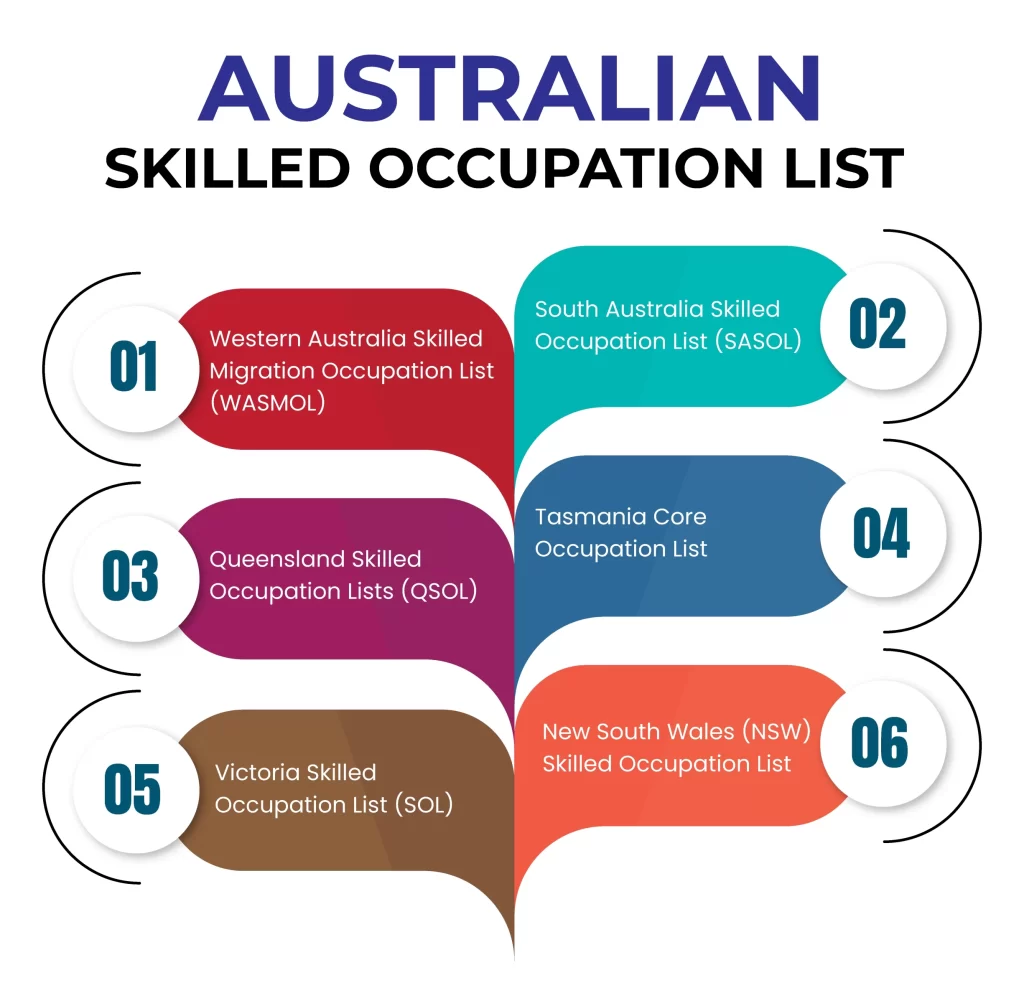As we all know, Australia is one of the most desirable countries in the world, its strong economy, high quality of life, and stunning natural beauty make it so. Most of us dream of moving there, to do that as a skilled professional, you need to know what, why, and how the Australian skilled occupation list works there.
Don’t worry, this blog has got you! Skilled migration is your ideal road to permanent residency there, so let’s check out how this works and which in-demand careers are on the Australian skilled occupation list this year.
Table of Content
1What is the Skilled Occupation List for Australia2Types of Australian Skilled Occupation List3Australian Skilled Occupation List4Skill Shortage List Australia5Skilled Visa Australia Requirements6How to Get Skilled Visa Australia7Wrap up8Frequently Asked Questions
What is the Skilled Occupation List for Australia
Imagine a roadmap designed to connect skilled workers with industries that need them the most, this is exactly what the SOL does. It includes Australia’s most in-demand occupations like healthcare, engineering, IT, and is regularly updated to match labor market needs. If your occupation is listed, you may qualify for a skilled visa, opening doors to long-term career growth, financial stability, and even permanent residency.
For aspiring migrants, the SOL is more than just a list, it’s an opportunity. It helps Australia fill the skill shortages while providing talented professionals a chance to work and live in a thriving and multicultural environment. If your skills align with Australia’s needs, this could be the perfect chance.
Types of Australian Skilled Occupation List
There is a total 4 types of lists including the recently introduced core skills occupational list, just take a detailed look at them
1. Medium and Long-term Strategic Skills List (MLTSSL)
- MLTSSL occupations are selected based on current labour market needs and Australia’s long-term economic priorities.
- This list is used as a reference for visas like skilled independent visa (Subclass 189), skilled nominated visa (Subclass 190), skilled work regional (Subclass 491).
- Eligible for PR pathways
- Occupations include doctors, engineers, IT professionals, nurses.
2. Short-Term Skilled Occupation List (STSOL)
- STSOL occupations address short-term demand and support temporary migration for 2 to 4 years. And supports permanent migration also, through Subclass 190 visa.
- For visas like employer-sponsored visa program, temporary skill shortage visa (subclass 482), and skilled regional (provisional) visa (subclass 491)
- Occupations include Marketing Specialists, Event Managers
3. Regional Occupations List (ROL)
- This Australian skilled occupation list lists occupations in high demand in specific regions of Australia.
- For skilled work regional (subclass 491) visa and employer-sponsored regional (subclass 494) visa.
- Encourages skilled workers to settle in regional areas.
- Occupations include Primary School Teachers, Agricultural Scientists, Physiotherapists.
4. Core Skills Occupations List (CSOL)
- Newly introduced to replace complex, out-of-date, and inflexible occupation lists in the temporary skilled visa program.
- The CSOL will apply to the core skills stream of the new skills in demand (SID) 482 visa which will replace the subclass 482 visa.
- Direct entry stream of the employer nomination scheme (Subclass 186) visa for permanent migration
Australian Skilled Occupation List
In Australia, there are 6 states where we can be migrated. Each state has a different priority list of occupations.

1. Western Australia Skilled Migration Occupation List (WASMOL)
Western Australia is one of the most preferred destinations for skilled migrants. To streamline migration, the WASMOL plays a crucial role in identifying high-demand occupations and guiding the state’s nomination process.
The WASMOL is divided into two primary streams: the general stream and the graduate stream.
1. General Stream further split into:
- Schedule 1 – lists occupations that are highly in demand across the state, giving applicants a higher chance of nomination.
- Schedule 2 – Includes occupations that are needed in specific areas or industries, often with stricter eligibility criteria.
2. The Graduate Stream is designed specifically for international students who have completed their studies at a Western Australian institution, providing them a pathway to skilled migration.
Some occupations on the Schedule 1 list which are mostly
| Occupation | ANZSCO Code | Assessing Authority |
|---|---|---|
| Dentist | 252312 | ADC |
| Registered Nurse | 254418 | ANMAC |
| Social Worker | 272511 | AASW |
| General Practitioner | 253111 | MedBA |
| Medical Laboratory Technician | 311213 | AIMS |
Some occupations on the Schedule 2 list
| Occupation | ANZSCO Code | Assessing Authority |
|---|---|---|
| Customer Service Manager | 149212 | VETASSES |
| Veterinarian | 234711 | AVBC |
| Architect | 232111 | AACA |
| Civil Engineer | 233211 | Engineers Australia |
| Primary School Teacher | 241213 | AITSL |
| Software Engineer | 261313 | ACS |
Some occupations on the Graduate Stream
| Occupation | ANZSCO Code | Assessing Authority |
|---|---|---|
| Accountant | 221111 | CAANZ, CPAA, IPA |
| Chef | 351311 | TRA |
| University Lecturer | 242111 | VETASSES |
Official site for more reference:
2. South Australia Skilled Occupation List (SASOL)
This Australian skilled occupation list is essential for driving the state’s economic growth by attracting skilled migrants with the qualifications and expertise needed to fill critical roles across various industries.
The list features 23 categories of in-demand occupations. Including Farmers and Farm Managers, Specialist Managers, Hospitality, Retail & Service Managers, Arts & Media Professionals, and 19 more.
| Occupation | ANZSCO Code | Assessing Authority |
|---|---|---|
| Specialist Managers | ||
| Sales and Marketing Manager | 131112 | IML |
| Hospitality, Retail & Service Managers | ||
| Cafe or Restaurant Manager | 141111 | VETASSES |
| Business, Human Resource & Marketing Professionals | ||
| Human Resource Advisor | 223111 | VETASSES |
| Design, Engineering, Science & Transport Professionals | ||
| Fashion Designer | 232311 | VETASSES |
| Mechanical Engineer | 233512 | Engineers Australia |
| Educational Professionals | ||
| Secondary School Teacher | 241411 | AITSL |
| Health Professionals | ||
| General Practitioner | 253111 | MedBA |
| Physiotherapists | 252511 | APC |
| ICT Professionals | ||
| Web Developer | 261212 | ACS |
| Construction Trades Workers | ||
| Plumber | 334111 | TRA |
| Carpenter | 331212 | TRA |
Official site for more reference:
3. Queensland Skilled Occupation Lists (QSOL)
Migration Queensland will select candidates whose occupations are listed on the home affairs eligible occupations list, prioritising those that help address critical skill shortages in Queensland’s expanding industries, including:
- Energy
- Construction and infrastructure
- Healthcare and social assistance
- Education
- Professional services
- Agribusiness
- Tourism and Hospitality
- Transport
| Occupation | ANZSCO Code | Assessing Authority |
|---|---|---|
| Construction Project Manager | 133111 | VETASSES |
| Chemical Engineer | 233111 | Engineers Australia |
| Geologist | 234411 | VETASSES |
| Power Generation Plant Operator | 399213 | TRA |
| Petroleum Engineer | 233612 | Engineers Australia |
Official site for more reference:
4. Tasmania Core Occupation List
The occupations listed below are prioritized for registrations of interest in the Migration Tasmania Gateway.
| Occupation | ANZSCO Code | Assessing Authority |
|---|---|---|
| ICT Managers | 135111, 135112, 135199 | ACS |
| Engineers | 233111, 233112, 233612 | Engineers Australia |
| Optometrists | 251411, 251412 | OCANZ, VETASSES |
| Pharmacists | 251511, 251512, 251513 | APharmC, VETASSES |
| Nurse Practitioner | 254411 | ANMAC |
| Clinical Psychologists | 272311 | APS |
Official site for more reference:
5. Victoria Skilled Occupation List (SOL)
All occupations on the relevant Department of Home Affairs Occupation List aka Australian skilled occupation list are eligible for Victorian nomination. However, priority will be given to specific occupations in the following industry sectors:
- Health
- Social services
- Education (including early childhood)
- Construction
- New energy
- Digital economy (for the 491 visa)
- Advanced manufacturing (for the 491 visa)
- Hospitality and tourism (for the 491 visa)
For subclass 491 applicants residing overseas, priority will be placed on the first 3 in the above list.
Official site for more reference:
6. New South Wales (NSW) Skilled Occupation List
The NSW skills list defines the occupations eligible for nomination under the skilled nominated visa (subclass 190) and the skilled work regional visa (subclass 491). They identify the critical skills needed to drive the growth and development of New South Wales.
Official site for more reference:
Skill Shortage List Australia
The occupation shortage list provides an up-to-date assessment of workforce shortages across different occupations in the Australian labor market. It identifies whether shortages exist nationwide or are specific metropolitan or regional areas.
| ANZSCO | Occupations | Aus | NSW | VIC | QLD | SA | WA | TAS | NT | ACT |
|---|---|---|---|---|---|---|---|---|---|---|
| 253911 | Dentist | S | S | S | S | S | S | S | S | S |
| 241111 | Early Childhood (Pre-primary School) Teacher | S | S | S | S | S | S | S | S | S |
| 341111 | Electrician | S | S | S | S | S | S | S | S | S |
| 232311 | Fashion Designer | NS | S | NS | NS | NS | NS | NS | NS | NS |
| 253111 | General Practitioner | S | S | S | S | S | S | S | S | S |
| 254411 | Nurse Practitioner | S | S | S | S | S | S | S | S | S |
| 252411 | Occupational Therapist | S | S | S | S | S | S | S | S | S |
| 251411 | Optometrist | S | S | S | R | S | S | S | S | S |
| 252511 | Physiotherapist | S | NS | S | R | S | S | S | S | S |
| 253511 | Surgeon (General) | S | NS | S | S | S | S | S | NS | S |
Here ‘S’ stands for shortage, ‘NS’ stands for no shortage, and ‘R’ stands for regional shortage.
Skilled Visa Australia Requirements
As a requirement to attain any skilled visa to Australia, there are some criteria you must be eligible for.
1. Australian Skilled Occupation List (SOL)
To qualify for skilled migration to Australia, your occupation must be listed on the skilled occupation list, which includes numerous in-demand roles across industries such as engineering, healthcare, IT, and trades. You must select one from the relevant list, such as MLTSSL or the STSOL, depending on your visa type.
2. Skills and Qualifications
Your skills and qualifications must match the occupation you are applying for and comply with Australian standards.
3. Point-Based System
Australia’s point-based system evaluates qualifications based on age, English proficiency, work experience, education, and other factors
4. Age
To be eligible, you must be between 18 and 45 years old at the time of receiving an invitation.
5. Language Proficiency
You must show English proficiency by taking an approved test such as IELTS, TOEFL, or PTE Academic. This will affect your points.
6. Qualifications and Work Experience
Your qualification must be recognised in Australia, and you need relevant work experience in your field. The points awarded depend on this.
7. Health and Character Requirements
You must complete a medical examination with authorised healthcare professionals and submit character references as part of the assessment process.
How to Get Skilled Visa Australia
Here are the steps to apply for Australian skilled migration
1. Check Eligibility
Check if your occupation is on the Australian skilled occupation list and score at least 65 points. Obtain a positive skills assessment from the relevant Australian authority for your nominated occupation.
2. Submit an Expression of Interest (EOI)
Use skillselect to submit an EOI, providing detailsabout your skills, qualifications, and relevant experience. EOI can be submitted for various skilled visa subclasses.
3. Receive an Invitation to Apply (ITA)
If selected you will receive an invitation to apply. You then have 60 days to submit your visa application.
4. Apply for a Visa
Complete your visa application online via the Department of Home Affairs. Submit required documents like skills assessment, ID proof, and work experience. Pay the application fee.
5. Meet Health and Character Requirements
Undergo a medical examination and obtain a police clearance certificate.
6. Wait for Visa Processing
They will assess your application. Processing times vary based on the visa subclasses and individual circumstances. If approved you will receive a visa grant notification.
Wrap up
By understanding the Australian skilled occupation list, the Australian Skilled migration program may seem complex, but it ain’t that hard when you’ve planned well and have expert guidance. We CanApprove come your way at just the right time. Let’s start your journey to this flourishing country without any delay.





